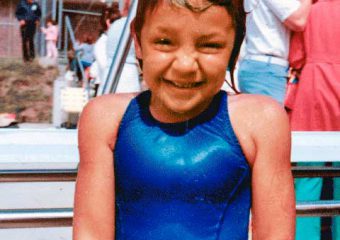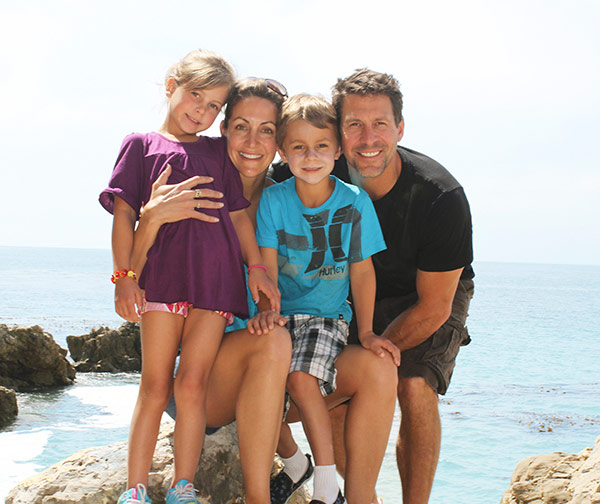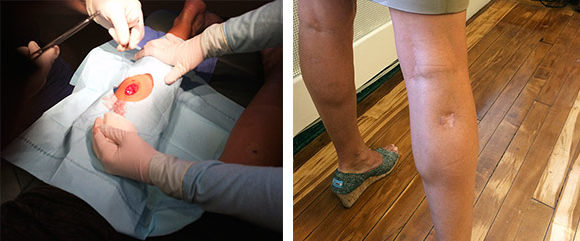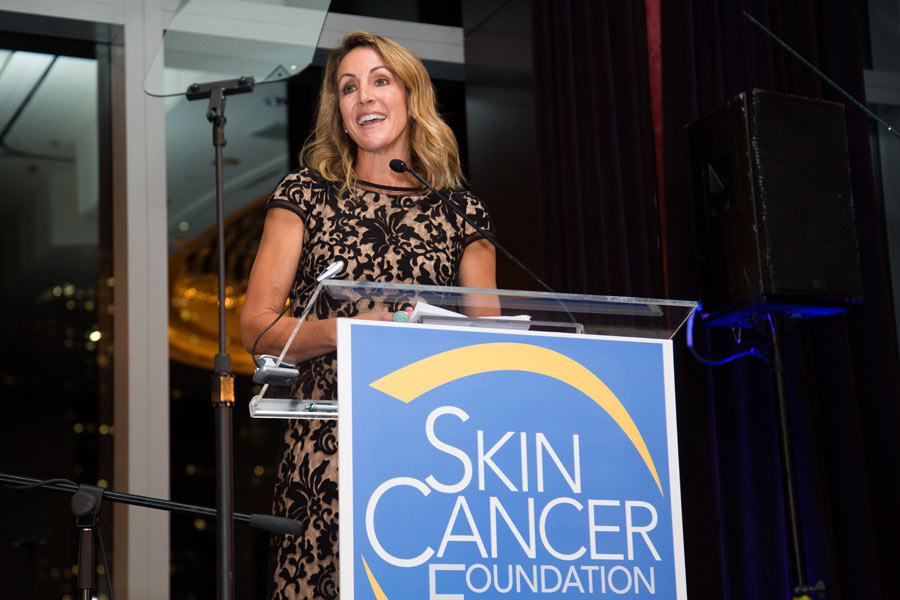Outdoor training was always part of this Olympic gold medalist’s active lifestyle. Using sunscreen religiously wasn’t a top priority, though, until she was diagnosed with melanoma. That spurred her to a new goal: to help others avoid skin cancer.
The last thing Summer Sanders expected to hear at a routine visit to her dermatologist was the word “melanoma.”
Although the olive-skinned swimmer had grown up training in outdoor pools under the intense California sun, she had never consciously tried to get tan and never considered herself at risk for skin cancer. It just wasn’t on her radar, especially when making it into the Olympics took so much of her focus.
She was lucky that the small brown spot on the back of her calf was an early stage I tumor, with a very high chance of a cure. After she had surgery to remove it in the fall of 2014, though, she was soon diagnosed with two more melanomas.
Her three scars were a wake-up call. “I decided I needed to find my voice and do something,” she says. She shared her story with The Skin Cancer Foundation’s supporters gathered at the Champions for Change Gala in October 2016 (above). She also speaks to other groups, to help kids and adults learn from her experience.
Her credentials: Born on October 13, 1972, in Roseville, California. Won four Olympic medals (two gold, one silver, one bronze) in swimming at the 1992 Olympic Games in Barcelona. Became a TV host, commentator and correspondent, most recently as cohost of CBS Sports Network’s award-winning sports talk show We Need to Talk. She’s a volunteer spokesperson for the John Wayne Cancer Foundation’s Block the Blaze program, which educates junior lifeguards and other kids about skin cancer. She also serves on the board of Right to Play and the USA Swimming Foundation. She and her husband, Olympic skier Erik Schlopy, have two children and live in Park City, Utah.
How she got her name: “My mom and dad’s first baby was born on the first day of summer, but he turned out to be a boy so they named him Trevor. My mom still loved the name Summer, though, so when I came along she gave it to me, even though I was born in October.”
 Earliest watery memory: “We were fortunate to have a backyard pool, and I was in the water all the time. I started swimming lessons at 18 months, but from a very early age I didn’t like people telling me what to do. I wanted to go at my own pace, so I hung onto the edge of the pool until about 3 (right), when I just started swimming. Apparently I had been paying attention all along. It was lucky that I found what I was really good at.”
Earliest watery memory: “We were fortunate to have a backyard pool, and I was in the water all the time. I started swimming lessons at 18 months, but from a very early age I didn’t like people telling me what to do. I wanted to go at my own pace, so I hung onto the edge of the pool until about 3 (right), when I just started swimming. Apparently I had been paying attention all along. It was lucky that I found what I was really good at.”
Relationship with the sun: “I grew up in Northern California in the valley, where it could be 110 degrees in the summer. My dad would never turn on the air-conditioning since we had an outdoor pool. So, I was outside all day, every day, in the pool, playing and running around. I couldn’t care less about a tan. I was never into laying out. I was never in a tanning bed. But I just didn’t associate sunscreen with my own backyard pool and playing. And as an athlete, I didn’t associate sunscreen with training. By the time I was in high school, I was certainly aware of the need for sun protection, but not as an everyday thing. I used sunscreen on vacations, like when we went to LA or Hawaii and were at the beach. Back then we only had products with SPF 4 or 8, and I’m not sure how much good they did. I do remember some painful sunburns [which are known to increase the risk of melanoma].”
What motivates her: “In my youth it was something simple my coach said: ‘No deposit, no return.’ It’s about owning and being accountable. I still draw on that advice quite often.”
Her transition from athlete to TV star: “I always knew I wanted to be in television. Before one of my first on-air interviews, my dad gave me good advice: ‘Just be yourself.’ And I thought, who else would I be? It would be so complicated. Being yourself should be your simplest and easiest way to live. So I just said what I felt, and that has worked out well for me.”
Her kids in a nutshell: “At 8, my son, Spider (named after ski racer Spider Sabich), is laser-focused and hilarious. At 10, my daughter, Skye, is clever and sweet. I say to her all the time, ‘I would want you as my friend.’ She constantly displays integrity beyond her years.”

Summer makes sure her husband, Olympic skier Erik Schlopy, and their kids, Skye and Spider, are slathered in water-resistant sunscreen before outdoor activities.
All that genetic athletic aptitude: “My kids don’t feel pressure yet to be athletes, but I have a feeling that may be coming at some point. They’re just now really aware that both their parents were Olympians. Erik and I are not sure we wish sport greatness on them. It certainly does mean sacrifices.”
How she was diagnosed: “I saw my dermatologist in 2014 about an unusual dry patch on my face. It turned out to be nothing to worry about. I was about to leave when I decided to mention a small dark-brown spot on the back of my right calf. It had appeared within the past two years, and my husband mentioned that I should have it checked. The doctor seemed a little concerned about a new mole at my age. My instincts kicked in, and I decided to push for him to remove it then and there. I’m grateful I did. It was stage I, but if the melanoma had been left to grow, it could have become invasive and even life-threatening.”

A small dark-brown spot on the back of Summer’s leg turned out to be stage I melanoma (during her surgery, above left, and her scar as it looks now, above right).
On her wake-up call: “Right after my surgery, I pointed out a faint spot on my other calf that was also fairly new. The doctor said he normally would not remove a spot like that, but since I said it started like the other one, he would take it off. Good thing we did, as the biopsy showed it was another melanoma, and caught early. From that point on I became vigilant about checking my skin, which led to my third diagnosis, on the back of my arm, in August 2015. Both of these were discovered at stage 0, or melanoma in situ. If I hadn’t pushed for these tiny spots to be checked out, they could have grown and been much worse. I am so lucky to be cancer-free after detecting all three of my melanomas early.”
How she changed her habits after her diagnosis: “My experience motivated me to make sun protection a top priority, both for myself and for my family. We wear sun-protective clothing at the beach — especially when we’re in the ocean all day. We bring umbrellas to create our own shade at the beach or other venues. I try to run earlier in the day so that my exposure is less intense. Hats are a must! I now tell athletes that applying water-resistant sunscreen before practice is crucial. When we’re skiing, everyone in my family wears sunscreen. The winter sun is brutal and not to be taken lightly. It can also be very deceiving. People think, ‘It’s too cold to get sunburned!’ That couldn’t be further from the truth.”
What she’s learned from fighting melanoma: “I thought I was one of those people who would never get skin cancer. I was wrong. Knowledge is key. The more questions you ask, the more you can understand. You know your body better than anyone else. With skin cancer, you don’t have to go in for a CT scan or MRI to detect it. We just need to look at ourselves and each other. I walk up to strangers and say, ‘How long have you had that freckle? You need to get that checked out.’ Look after yourself, look after each other. Now is the time for us to take this seriously and take action.”
Photos courtesy of Summer Sanders.
* This article was first published in the 2017 issue of The Skin Cancer Foundation Journal.





